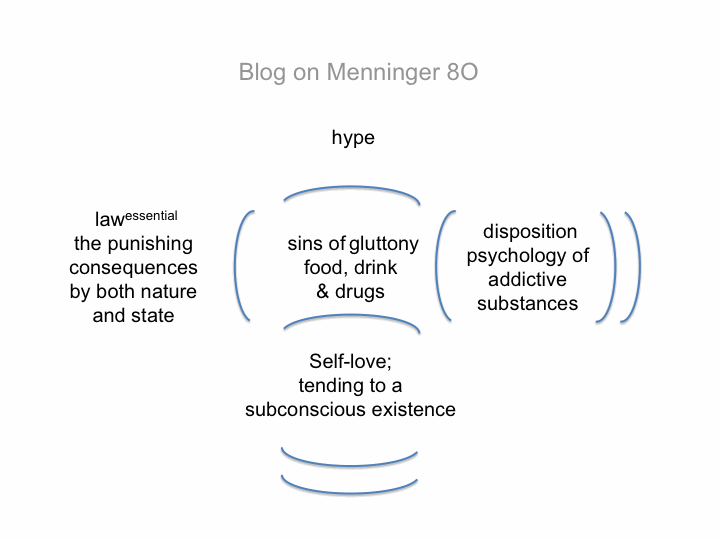Monthly Archives: October 2013
Thoughts on Whatever Became of Sin? By Karl Menninger MD (1973) 8N
What about the vertical axis for gluttony – food, drinks and drugs?
Menninger associated gluttony to a destructive self-love, tending towards a “subconscious existence”. This certainly fits the “loss of conscience” that makes “sins of gluttony possible”.
Menninger did not explore the thinkgroup that puts the sins of food, drinks and drugs into context. But, like most Progressives, he made fun of quaint religious traditions of thinkdivine that forbid coffee, tea and beer.
But I have an example: Consider that great propagandizer of self-love and subconscious existence: American television (any time, from 1960 to 2012). TV thinkgroup romanticized all types of addictions, including the most important one: addiction to itself.
So for TV gluttony, the vertical axis might be “television hype for the goodness of its own programming and ads(sin of being a couch potato(destructive self love tending toward a subconscious existence))”.
Now, what about the Gluttony for Entitlements by the Central Government?
Thoughts on Whatever Became of Sin? By Karl Menninger MD (1973) 8M
Let us turn to the next set of sins in Chapter 8: “Gluttony – Food, Drinks and Drugs”.
What makes the “sins of gluttony” possible? Pleasurable substances plus the psychology (or neurophysiology) of addiction make good candidates for “symptoms”.
What puts the “the sins of gluttony” into context? The “crimes” of obesity, intoxication, drunkenness and addiction made good candidates for “crimes”.
Again, we find opportunity to expand the concept of “crime”. Menninger limited “crime” to the jurisdiction of the state. “Crime” could also include the punishing natural consequences of the sin. Thus, the word “crime” might be replaced by a more general term, such as lawnature or lawessential.
Similarly, Menninger’s idea of “symptom” was “something that would be subject to improvement by a psychoanalyst or mental health worker”. We can expand this concept by substituting the word “disposition” for “symptom”.
The horizontal axis of “lawessential(sin(disposition))” would be, for this set of sins, “the punishing consequences by both nature and state(sins of gluttony(the psychology or neurophysiology of pleasurable substances)).
Thoughts on Whatever Became of Sin? By Karl Menninger MD (1973) 8L
Before modernism, the horizontal “crime(sin(symptom))” might be expressed – er, maybe ‘repressed’ – as “this is reprehensible(sin of sensuality(the temptations of lust).
The vertical “thinkdivine(virtue(consciencefree))” might be – perhaps – “divine judgment(self-denial(avoid the vice of lust))”.
The two of the poles of “divine judgment” and “this is reprehensible” must have put a damper on the sins of sensuality. Believers worked hard to avoid both “tempting thoughts” (which might correspond to “symptom”) and “the vice itself” (which would correspond to a free will decision to commit the deed).
Menninger was on target by nominating St. Anthony to be the poster child of this premodern mandala.
There is a certain beauty to the Temptations of St. Anthony. “Divine judgment” told St. Anthony ‘something’ that he did not want to hear, and yet, he could not reject that voice?
This beauty precisely opposes the beauty of the serpent in An Archaeology of the Fall, a serpent that captures the nature of thinkgroup: The serpent tells you what you want to hear.

